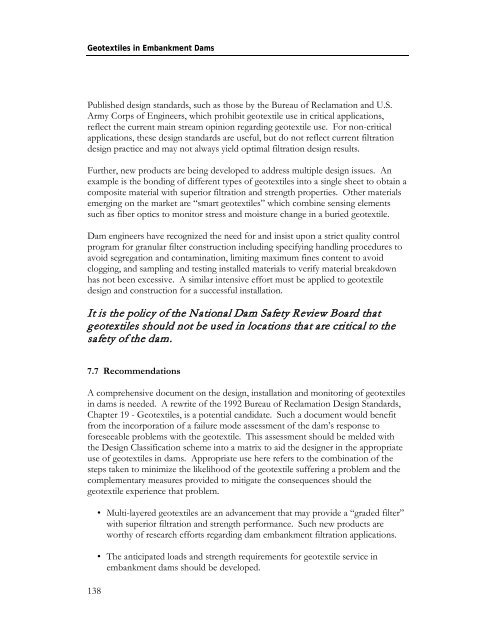Geotextiles in Embankment Dams - Association of State Dam Safety ...
Geotextiles in Embankment Dams - Association of State Dam Safety ...
Geotextiles in Embankment Dams - Association of State Dam Safety ...
You also want an ePaper? Increase the reach of your titles
YUMPU automatically turns print PDFs into web optimized ePapers that Google loves.
<strong>Geotextiles</strong> <strong>in</strong> <strong>Embankment</strong> <strong><strong>Dam</strong>s</strong>Published design standards, such as those by the Bureau <strong>of</strong> Reclamation and U.S.Army Corps <strong>of</strong> Eng<strong>in</strong>eers, which prohibit geotextile use <strong>in</strong> critical applications,reflect the current ma<strong>in</strong> stream op<strong>in</strong>ion regard<strong>in</strong>g geotextile use. For non-criticalapplications, these design standards are useful, but do not reflect current filtrationdesign practice and may not always yield optimal filtration design results.Further, new products are be<strong>in</strong>g developed to address multiple design issues. Anexample is the bond<strong>in</strong>g <strong>of</strong> different types <strong>of</strong> geotextiles <strong>in</strong>to a s<strong>in</strong>gle sheet to obta<strong>in</strong> acomposite material with superior filtration and strength properties. Other materialsemerg<strong>in</strong>g on the market are “smart geotextiles” which comb<strong>in</strong>e sens<strong>in</strong>g elementssuch as fiber optics to monitor stress and moisture change <strong>in</strong> a buried geotextile.<strong>Dam</strong> eng<strong>in</strong>eers have recognized the need for and <strong>in</strong>sist upon a strict quality controlprogram for granular filter construction <strong>in</strong>clud<strong>in</strong>g specify<strong>in</strong>g handl<strong>in</strong>g procedures toavoid segregation and contam<strong>in</strong>ation, limit<strong>in</strong>g maximum f<strong>in</strong>es content to avoidclogg<strong>in</strong>g, and sampl<strong>in</strong>g and test<strong>in</strong>g <strong>in</strong>stalled materials to verify material breakdownhas not been excessive. A similar <strong>in</strong>tensive effort must be applied to geotextiledesign and construction for a successful <strong>in</strong>stallation.It is the policy <strong>of</strong> the National <strong>Dam</strong> <strong>Safety</strong> Review Board thatgeotextiles should not be used <strong>in</strong> locations that are critical to thesafety <strong>of</strong> the dam.7.7 RecommendationsA comprehensive document on the design, <strong>in</strong>stallation and monitor<strong>in</strong>g <strong>of</strong> geotextiles<strong>in</strong> dams is needed. A rewrite <strong>of</strong> the 1992 Bureau <strong>of</strong> Reclamation Design Standards,Chapter 19 - <strong>Geotextiles</strong>, is a potential candidate. Such a document would benefitfrom the <strong>in</strong>corporation <strong>of</strong> a failure mode assessment <strong>of</strong> the dam’s response t<strong>of</strong>oreseeable problems with the geotextile. This assessment should be melded withthe Design Classification scheme <strong>in</strong>to a matrix to aid the designer <strong>in</strong> the appropriateuse <strong>of</strong> geotextiles <strong>in</strong> dams. Appropriate use here refers to the comb<strong>in</strong>ation <strong>of</strong> thesteps taken to m<strong>in</strong>imize the likelihood <strong>of</strong> the geotextile suffer<strong>in</strong>g a problem and thecomplementary measures provided to mitigate the consequences should thegeotextile experience that problem.138• Multi-layered geotextiles are an advancement that may provide a “graded filter”with superior filtration and strength performance. Such new products areworthy <strong>of</strong> research efforts regard<strong>in</strong>g dam embankment filtration applications.• The anticipated loads and strength requirements for geotextile service <strong>in</strong>embankment dams should be developed.
















